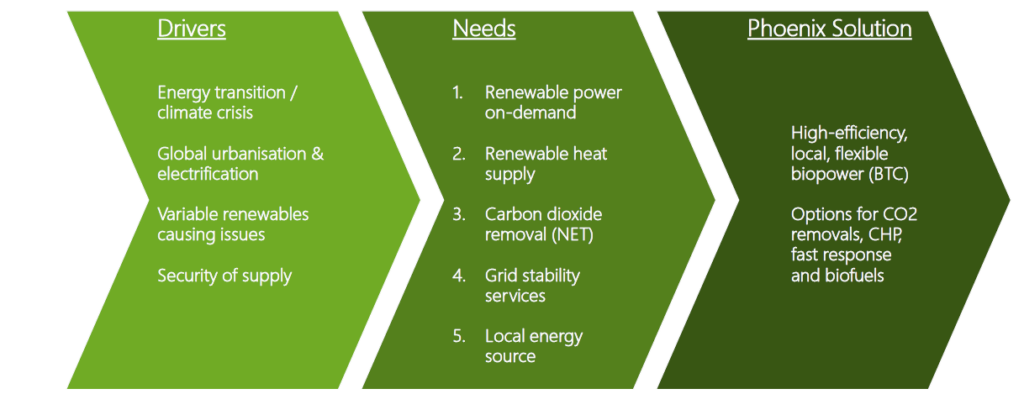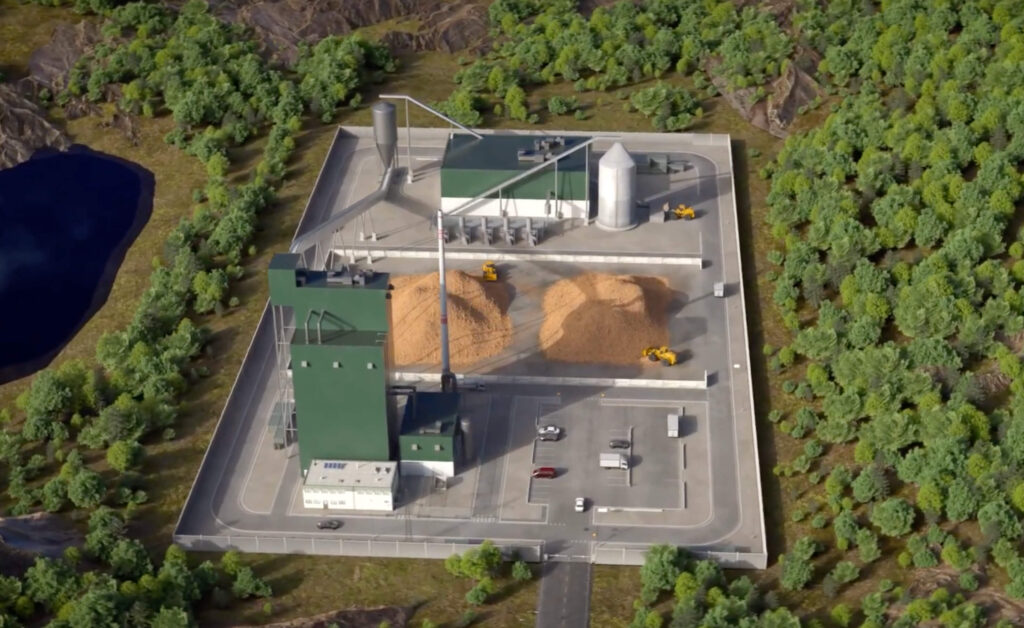Reasons to invest in Bio-FlexGen
In the journey towards a post-fossil economy, the energy transition demands substantial investments in renewable power generation. A pivotal solution in achieving this goal is biopower. It offers versatile options such as district heating and carbon dioxide removal to achieve negative emissions.
The Biomass-fired Top Cycle (BTC) plant is currently under development within the Bio-Flex Gen project. This cutting-edge technology was created by our Swedish start-up Phoenix BioPower to meet the requirements of the energy transition. It will hit the market within four years:
- On-demand power: Flexible, local, renewable
- Biomass wastes as feedstock (i.e. forest, agriculture and demolition)
- Carbon Dioxide Removal (CDR) credits and biofuel options
- 50-80% more electricity from biomass
- 3 x more local power from district heating (CHP)
- Carbon-negative power at 50 % higher net efficiency
- Highly efficient and cost-effective
2. Energise!
The EU’s commitment to achieving climate neutrality by 2050 is in harmony with the European Green Deal. This groundbreaking energy transition presents both challenges and opportunities for a sustainable future. To realise this vision, the European energy sector must establish three crucial goals, among others:
- Surging demand for renewable electricity fuels the global energy transition.
- The intermittency of wind and solar power introduces substantial system costs.
- Robust carbon removal technologies come at a price ranging from 200 to 1000 €/t.
- Ensuring security of supply emerges as a critical concern.

3. Capacity for Biopower
The substantial expansion of the biopower sector presents an outstanding opportunity for investors to enhance their revenue streams. Projections indicate that the biopower market will achieve a Compound Annual Growth Rate (CAGR) of 10-15% until 2050. Ultimately, it is estimated to reach a market value of 150 billion Euros by then.
4. The game changer: Carbon Dioxide Removal
The combination of the BTC technology with carbon capture capabilities has enormous potential. It can capture a substantial 100 million tons of biogenic carbon worldwide by 2050 – annually. Achieving this would only necessitate 1% of sustainably sourced biomass residues. It could result in a thriving industry worth 10 to 20 billion euros, with the potential to install up to 100 units per year. A true game-changer with remarkable impact!
5. Unleashing the Full Potential!
To develop a groundbreaking utility-scale technology such as the BTC, collaboration is key. Our start-up Phoenix BioPower is actively engaging in collaborations with various research institutes, universities, and established companies:
- RISE, TU Berlin and KTH for research and development.
- For the development of the patented gas turbine, Phoenix cooperates with the Zorya Mashproekt.
- On a commercial level, Phoenix Biopower cooperates with the British global biopower leader Drax Group and the Swedish municipal utility Tekniska Verken, to name only a few.
To enter the market seamlessly, Phoenix BioPower will establish additional partnerships. These will address critical areas such as Project development, Engineering, Procurement, Construction (EPC), Original Equipment Manufacturers (OEM). Moreover, Phoenix BioPower will secure both private and public financing.
6. What Do the Key Performance Indicators (KPIs) Reveal?
Technical: Assessing factors such as the operating range, ramp rate, startup time, total efficiency, and Net Hydrogen Efficiency.
Economic: Evaluating metrics like Operation Expenses (OpEx), Capital expenditures (CApEx), and cost-effectiveness.
Environmental: Measuring the generation of Renewable Energy Sources (RES), air pollution levels, and Greenhouse Gas Emissions (GHGs).
Social: The ongoing development and assessment of social aspects are currently in progress.
7. Playing by the rules
Focusing on combined heat and power (CHP) generation using renewable energy technology, Phoenix BioPower places significant importance on evaluating regulations and policies. In line with this, a comprehensive review of the regulatory environment for CHP was concluded in July 2022 within the Bio-FlexGen project scope. The report delves into the primary components of European policies that impact combined heat and power development. The regulatory framework is extensive and built upon various directives and regulations, such as:
- Renewable Energy Directive (RED): This directive establishes binding targets for the utilisation of renewable energy sources within the European Union. It outlines specific objectives for the share of renewables in each member country’s final gross energy consumption.
- The European Commission revised the RED in November 2023. Within the Revised Directive EU/2023/2413, the renewable target for 2030 has been raised to a binding minimum of 42.5%. This includes an aspiration to achieve 45%, surpassing the previous 32% target.
The Phoenix BioPower CHP plant perfectly aligns with the European Green Deal’s climate goals. To facilitate a rapid roll-out, the CHP Directive (2004/8/EC) emerged. It emphasises local heat demand. In addition, it promotes efficient cogeneration in industrial, district heating, and agricultural sectors. This directive signals a positive shift as it fosters sustainable energy practices. Making the Green Deal real!
8. The Financial Backing
Bio-FlexGen is made possible through funding from the European Union as part of the Horizon 2020 programme. Specifically, it is classified as a Research and Innovation Actions (RIA) project under Grant Agreement Number 101037085. Phoenix BioPower is part of the Bio-FlexGen research project. It is a Swedish start-up founded in 2016. Since then, Phoenix has raised 6 M€. in private funding and the same amount in public funding, including Bio-Flex Gen. The company has also raised additional 4,5 M€ in indirect funding to project partners. This amounts to a total funding of ca. 16,5 M€.
This is an overview of The Biomass-fired (BTC) plant.
For more detailed information, have a look at the BTC-plant infographic on our Bio-FlexGen website.
Copyright: Phoenix BioPower
Go here to view six good reasons at one glance.





